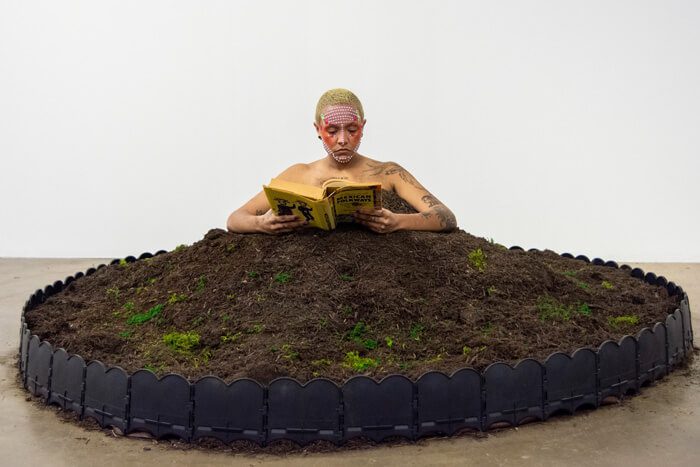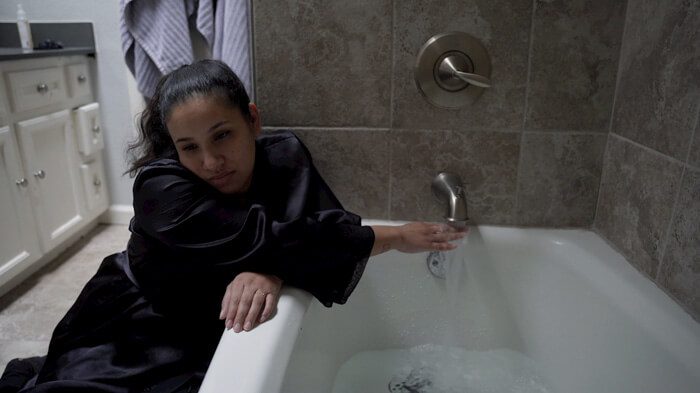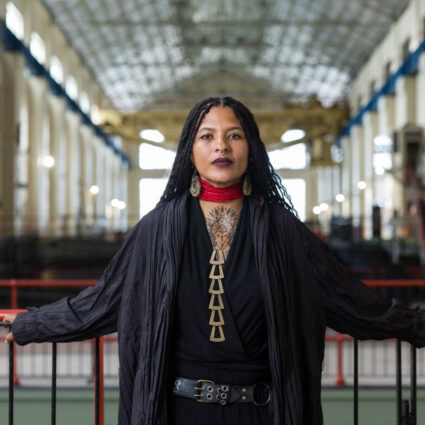Dallas artist Christian Cruz depicts the value of human interaction in a society taking inventory after so much loss and social reckoning.

The impulse to heal is an important link between participatory art-making and activism that focuses on care. This year it was sometimes hard to distinguish one from the other, especially since any careful gathering was therapeutic. Fantasies of rest and repair unfolded in parks and limited gallery spaces during the pandemic. In Dallas specifically, the Black Power Naps exhibition by Navild Acosta and Fanny Sosa appeared outdoors for the first time at Sweetpass Sculpture Park, inviting people to value idleness as power by relaxing in hammocks and focus on the restoration of energy to Black and Indigenous people and people of color. Artist Erica Felicella was mentioned on sports talk radio for her COVID-summing endurance piece Resistance, Re-Live and Proceed, in which she asked comers to place rocks on her body and release their grief at the end of the year.
Curator and organizer Ashara Ekundayo created a line of research around the idea of artists as first responders. This, of course, anticipates the cycle of violence and rescue, one that marks punitive systems of the world in which we live. Healing happens in a world apart from threat. It is quiet. It is work that needs a place of rest.
•
A performer sits in the center of a hill in the center of a gallery. The spectacular circle of dirt keeps her still and safe from passers-by. Her arms are free. From across the room, the pile of earth looks like the skirt of an elegant dress.
Her assignment from the artist Christian Cruz is to stay here for the next three hours and read to herself from A Treasury of Mexican Folkways by anthropologist Frances Toor. First published in 1947, it is an extensive collection of traditions, creation stories, ritual dances, games, art, and remedies gathered during the author’s studies in Mexico.
Toor published the bilingual journal Mexican Folkways for more than a decade before A Treasury came out. When it came to the field reporting that ultimately produced the 566-page book, Toor just “never seemed to be ‘working’ at it,” one reviewer wrote.
•
They Tried to Bury Us Proverb is the title Cruz gave to the dirt performance. In this version, Brooke Chaney, the performer, embodies the answering line of the familiar couplet (“they didn’t know we were seeds”). The piece is part of Cruz’s first solo show, Living Portraits of Abstract Rituals.
To Chaney’s right, as she tries to focus and be still at ex ovo in West Dallas in December, Paloma Salas faces a corner and carefully balances laundry baskets on her head, stacking them again and again after they fall. To the left, Colton White struggles in a black mask at the whims of the floating tree branch to which their waist is tied.

Around the corner from these three continuous performance pieces is a video work nestled in the back room called I don’t dream of labor. There, Cruz can be seen on screen, at home, letting her mind wander between things as she runs a bath for her daughter or prepares dinner. The sound reveals her thoughts in these moments alone with the viewer, who beholds the artist’s interior life of gratitude and joyful memories. Cruz’s stepdaughter watches the loop start again in the gallery, enrapt.
•
The artist shows the webcam a painting of her daughter breastfeeding. One artifact up for auction in playful, broad strokes and heavy shadows. There is a tender negotiation going on in the painting and the Zoom frame.
There was one thing left unpriced in the experiment: the artist’s own psychic energy during the session itself. How much was that worth?
Cruz is offering this personal work to patrons who submit angry stories instead of money for a performance experiment called Anger As Currency, produced with Chicago-based Chuquimarca Projects. The angrier the story, the more it could benefit the teller, who’d type out their expression of rage in exchange for a bid on Cruz’s drawings and ’zines. In September 2020 the mood on the wall of dark Zoom squares was pained. The artist was the only one in the meeting on camera. “It was just me,” she said later.
Distressing accounts of everyday racism, misogyny, and familial frustrations amid the pandemic took their turns in direct messages to the artist on Zoom chat. Cruz read each of them aloud. Later, she found herself depleted and looking for something to show for the night. Anger As Currency assigned functional worth to the vulnerability and emotional labor of participants who wrote and shared stories of trauma. It affirmed the value of the objects Cruz made and auctioned. There was one thing left unpriced in the experiment: the artist’s own psychic energy during the session itself. How much was that worth?
•
Cruz’s work makes it accessible and clear: the sacred exchange possible in performance art requires an ecosystem that would model health for other realms. This is not a moral prescription but a practical answer to the question of what human interaction is worth as material in a society taking inventory after so much loss and social reckoning.
Anger As Currency lives on in new movement pieces Cruz workshopped in virtual sessions with New York City-based organization Movement Research. Audio of the artist reading the angry stories scores the performances on video. While waiting for in-person programming to commence, Cruz began developing a Performance Art Index to nurture a scene in Dallas around live experimental work that falls outside the realms of theater and dance. Her Artist Mama Fund, in its second year, gives small, unrestricted grants to single mothers who are artists on Mother’s Day.
Cruz dreams of a sustainable place in Dallas for the work she loves. Studio space and funded residencies at major arts institutions in Dallas, Cruz suggests, would provide significant visibility and career growth. A new consideration of process, care, and intimacy as work in art seems natural after this long period of shared uncertainty, when we have gained a new understanding of how much work it takes to create spaces of rest.
Update 07/07/2025: This article has been updated to reflect that Cruz participated in the Movement Research sessions virtually.



